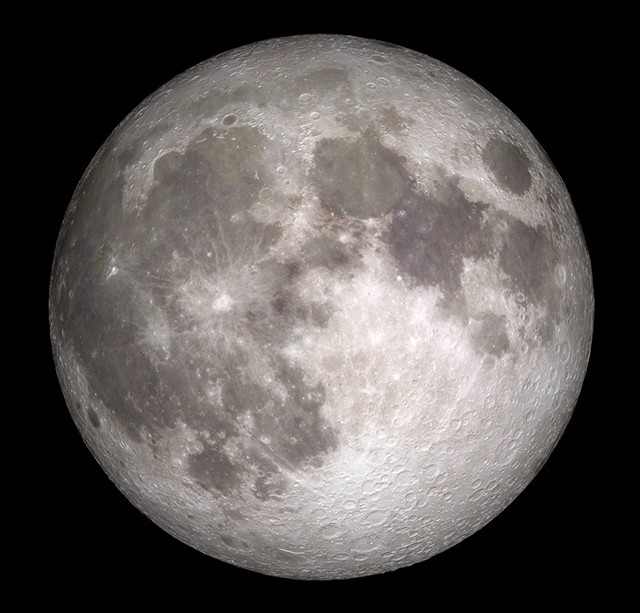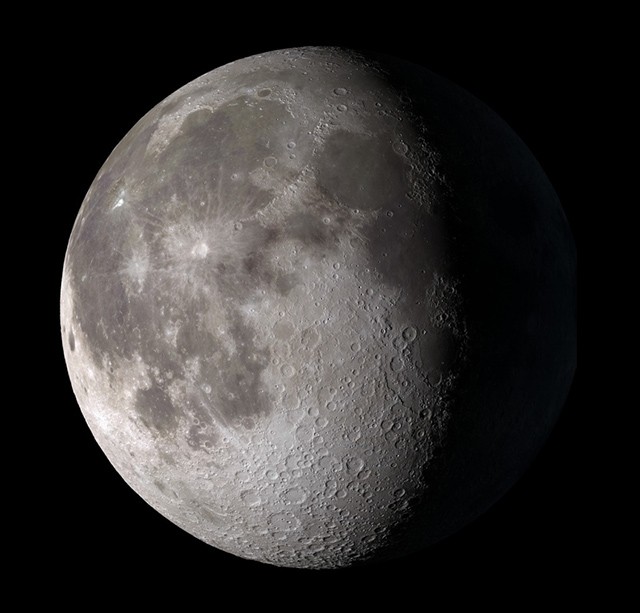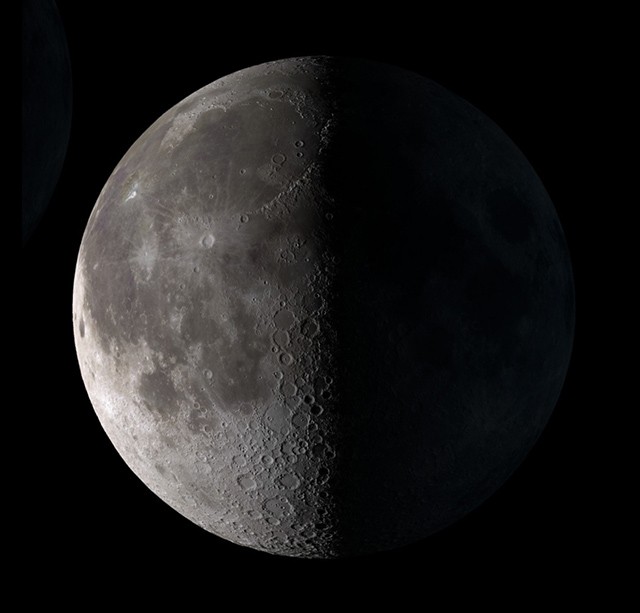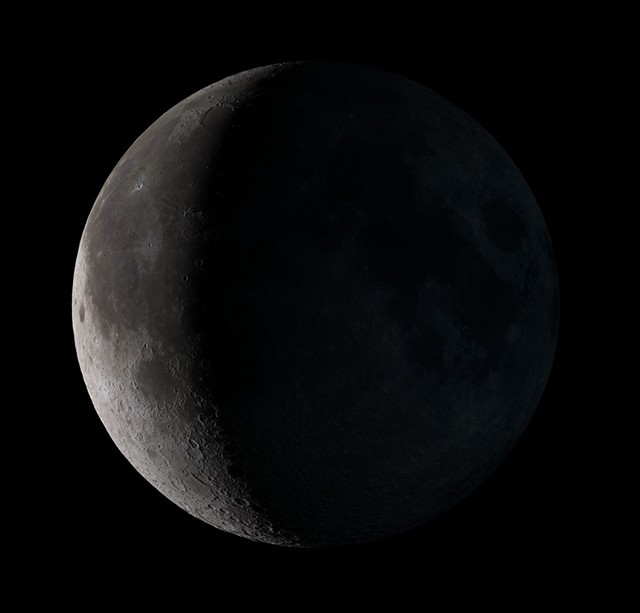Why does the moon have phases? This is a question that has intrigued humanity for centuries. At WHY.EDU.VN, we aim to provide a comprehensive answer, exploring the lunar phases, their causes, and their significance, helping you understand these celestial transformations, unraveling the lunar cycle and its various stages, and providing a detailed understanding of the lunar cycle. Delve into the concepts of solar illumination, lunar orbit, and Earth’s perspective.
1. Introduction to Moon Phases: A Celestial Dance
The moon, our closest celestial neighbor, undergoes a mesmerizing transformation each month, appearing to change shape in what we call moon phases. These phases, from the invisible new moon to the radiant full moon, are not caused by the Earth’s shadow, but rather by the changing angles at which we view the moon’s illuminated surface. This lunar cycle is a beautiful interplay of light and shadow, dictated by the moon’s orbit around Earth and its relationship to the sun.
1.1. The Basic Cause: Sunlight and Perspective
The primary reason for the moon phases is simple: the moon does not produce its own light. Like Earth, it is illuminated by the sun. As the moon orbits Earth, the amount of sunlight reflected towards us changes, creating the illusion of different shapes. During a lunar cycle, the moon transitions through phases such as the new moon, crescent, quarter, gibbous, and full moon, each offering a unique spectacle in the night sky.
1.2. The Lunar Cycle: A Monthly Journey
The lunar cycle, or synodic month, takes approximately 29.5 days to complete. This is the time it takes for the moon to go through all its phases and return to the same phase again. Understanding this cycle is crucial to grasping why we see the moon in different shapes throughout the month. The lunar cycle is influenced by the moon’s orbit, Earth’s orbit, and the relative positions of the sun, Earth, and moon.
2. The Eight Primary Moon Phases Explained
The lunar cycle is typically divided into eight distinct phases. Each phase represents a specific point in the moon’s orbit around Earth and the corresponding appearance of its illuminated surface as seen from our planet. Let’s explore each phase in detail.
2.1. New Moon: The Invisible Phase
The new moon marks the beginning of the lunar cycle. In this phase, the moon is between Earth and the sun, and its illuminated side faces away from us. As a result, the moon appears dark and invisible to the naked eye. Though unseen, the new moon is a critical point in the lunar cycle, setting the stage for the phases to come.
2.2. Waxing Crescent: A Sliver of Light
Following the new moon, a sliver of light begins to appear on the right side of the moon. This is the waxing crescent phase. “Waxing” means that the illuminated portion is growing. This phase is often visible shortly after sunset, appearing as a delicate curve in the western sky. The waxing crescent phase marks the gradual return of the moon’s light, signaling the progression of the lunar cycle.
2.3. First Quarter: Halfway There
About a week after the new moon, the moon reaches its first quarter phase. At this point, half of the moon’s face appears illuminated, while the other half is in darkness. The term “quarter” refers to the fact that the moon has completed one-quarter of its orbit around Earth since the new moon. During the first quarter, the moon rises around noon and sets around midnight, offering excellent viewing opportunities in the evening sky.
2.4. Waxing Gibbous: More Than Half
As the moon continues its orbit, more than half of its face becomes illuminated. This is the waxing gibbous phase. The term “gibbous” means that the shape is more than half but not full. The waxing gibbous moon is increasingly bright and prominent in the night sky, rising in the afternoon and remaining visible well into the night. This phase leads us closer to the full moon, where the moon’s entire face is illuminated.
2.5. Full Moon: A Circle of Light
The full moon is perhaps the most recognizable and celebrated of all the moon phases. In this phase, the moon is opposite the sun in the sky, and its entire face is fully illuminated. The full moon rises around sunset and sets around sunrise, bathing the night in its bright, silvery light. This phase is often associated with heightened emotions, folklore, and special events like lunar eclipses.
2.6. Waning Gibbous: Light Begins to Fade
After the full moon, the illuminated portion of the moon begins to decrease. This is the waning gibbous phase. “Waning” means that the illuminated portion is shrinking. The waning gibbous moon rises later each night and appears less bright than the full moon. This phase marks the beginning of the moon’s journey back towards the new moon, where it will once again become invisible.
2.7. Third Quarter: The Other Half
Approximately three weeks after the new moon, the moon reaches its third quarter phase, also known as the last quarter. Similar to the first quarter, half of the moon’s face appears illuminated, but this time it’s the opposite half. The third quarter moon rises around midnight and sets around noon, making it visible in the early morning sky. This phase signifies the moon’s continued journey towards the end of its cycle.
2.8. Waning Crescent: The Final Sliver
The waning crescent is the final phase of the lunar cycle before the new moon. It appears as a thin, shrinking sliver of light on the left side of the moon. The waning crescent is often visible in the early morning hours, just before sunrise. This phase marks the end of the lunar cycle, as the moon prepares to disappear into the darkness of the new moon once again.
3. The Science Behind Moon Phases
Understanding the science behind moon phases involves understanding the interplay of several factors, including the moon’s orbit, its rotation, and its position relative to the sun and Earth. By exploring these elements, we can gain a deeper appreciation for the celestial mechanics that govern the lunar cycle.
3.1. Lunar Orbit: An Elliptical Path
The moon’s orbit around Earth is not perfectly circular; it’s an ellipse, meaning it’s slightly oval-shaped. This elliptical orbit affects the moon’s speed as it travels around Earth. When the moon is closer to Earth (at perigee), it moves faster, and when it’s farther away (at apogee), it moves slower. This variation in speed contributes to the slight irregularities in the timing of the moon phases.
3.2. Synchronous Rotation: Always Showing One Face
The moon is tidally locked with Earth, meaning that its rotation period is equal to its orbital period. As a result, the moon always shows the same face to Earth. This phenomenon is not a coincidence; it’s caused by the gravitational interaction between Earth and the moon. Over billions of years, Earth’s gravity has slowed the moon’s rotation until it reached a point where it rotates at the same rate as it orbits.
3.3. Solar Illumination: The Source of Light
The sun is the primary source of light in our solar system, and it is responsible for illuminating the moon. As the moon orbits Earth, different portions of its surface are illuminated by the sun. The amount of illuminated surface that we see from Earth depends on the moon’s position relative to the sun and Earth. This changing perspective is what creates the moon phases.
4. Common Misconceptions About Moon Phases
Despite the relatively straightforward explanation of moon phases, several misconceptions persist. Addressing these misunderstandings can help clear up confusion and promote a more accurate understanding of this natural phenomenon.
4.1. Earth’s Shadow: Not the Cause
One of the most common misconceptions is that the Earth’s shadow causes moon phases. This is incorrect. Moon phases are caused by the changing angles at which we view the moon’s illuminated surface. Earth’s shadow does play a role in lunar eclipses, but these are distinct events from the regular phases of the moon.
4.2. The Dark Side of the Moon: Always Exists
Another misconception is that the “dark side of the moon” is a place that never sees sunlight. In reality, the moon rotates, so all parts of its surface experience day and night. The term “dark side of the moon” more accurately refers to the far side of the moon, which is the side that we cannot see from Earth due to tidal locking.
4.3. Moon Phases and Weather: No Proven Link
Some people believe that moon phases can affect the weather, but there is no scientific evidence to support this claim. While the moon’s gravity does influence tides on Earth, its effect on weather patterns is negligible. Any perceived correlation between moon phases and weather is likely due to coincidence or confirmation bias.
5. The Cultural Significance of Moon Phases
Throughout history, moon phases have held significant cultural and symbolic meaning for various societies around the world. The lunar cycle has been used to track time, plan agricultural activities, and inform religious practices. Exploring these cultural connections can enrich our appreciation for the moon and its influence on human life.
5.1. Lunar Calendars: Timekeeping Through the Ages
Many ancient cultures developed lunar calendars based on the phases of the moon. These calendars were used to regulate agricultural cycles, predict seasonal changes, and organize religious festivals. Examples include the Islamic calendar, the Hebrew calendar, and various ancient Chinese and Mesopotamian calendars. These calendars demonstrate the importance of the moon as a timekeeping tool in human history.
5.2. Mythology and Folklore: Lunar Deities and Legends
The moon has been personified as a deity in numerous mythologies around the world. In Greek mythology, the moon goddess is Selene, while in Roman mythology, she is Luna. These lunar deities are often associated with femininity, intuition, and the cycles of life. Folklore surrounding the moon phases includes beliefs about werewolves, lunar influences on human behavior, and omens associated with specific phases.
5.3. Modern Interpretations: Art, Literature, and Symbolism
The moon continues to inspire artists, writers, and thinkers in modern times. Moon phases are often used as symbols of change, transformation, and the passage of time. They appear in literature, music, and visual arts, evoking a sense of mystery, romance, and the sublime. The moon’s enduring presence in human culture underscores its profound impact on our collective imagination.
6. Observing the Moon: Tips and Techniques
Observing the moon is a rewarding experience that can deepen your connection with the natural world. Whether you’re a beginner or an experienced stargazer, there are several tips and techniques that can enhance your lunar observations.
6.1. When and Where to Look
The best time to observe the moon depends on its phase. Full moons are easily visible throughout the night, while crescent moons are best viewed shortly after sunset or before sunrise. To find the moon, look towards the east after sunset or the west before sunrise. Mobile apps and websites like Time and Date can help you track the moon’s position and phase in your location.
6.2. Using Binoculars and Telescopes
Binoculars are an excellent tool for observing the moon’s surface features, such as craters and maria (dark, smooth plains). A small telescope can reveal even more detail, allowing you to explore the moon’s rugged terrain and appreciate its beauty up close. When using a telescope, start with a low magnification and gradually increase it to get the best view.
6.3. Moon Gazing Apps and Resources
Numerous apps and websites provide information about the moon’s phase, position, and visibility. These resources can help you plan your observations and learn more about the moon’s features. Some popular apps include SkyView Lite, Star Walk 2, and NASA’s own Moon phases app.
7. The Moon’s Influence on Earth
The moon exerts a significant influence on Earth, primarily through its gravitational pull. This influence is responsible for tides, and it also plays a role in stabilizing Earth’s axis, which is critical for maintaining a stable climate.
7.1. Tides: The Moon’s Gravitational Pull
The moon’s gravity pulls on Earth, causing the oceans to bulge out on the side closest to the moon and the opposite side. These bulges create high tides, while the areas in between experience low tides. The sun also contributes to tides, but its effect is only about half as strong as the moon’s.
7.2. Stabilizing Earth’s Axis
The moon plays a crucial role in stabilizing Earth’s axis of rotation. Without the moon, Earth’s axis would wobble much more, leading to drastic changes in climate over time. The moon’s gravitational influence keeps Earth’s axial tilt relatively stable at 23.5 degrees, which is essential for maintaining predictable seasons.
7.3. Lunar Eclipses: A Celestial Alignment
Lunar eclipses occur when Earth passes between the sun and the moon, casting a shadow on the moon’s surface. These eclipses can only happen during a full moon when the sun, Earth, and moon are aligned in a straight line. Lunar eclipses are a beautiful and awe-inspiring reminder of the celestial mechanics that govern our solar system.
8. Advanced Lunar Phenomena: Beyond the Basics
Beyond the basic phases, there are several advanced lunar phenomena that are worth exploring. These phenomena offer a deeper understanding of the moon’s behavior and its interactions with Earth and the sun.
8.1. Lunar Libration: A Slight Wobble
Lunar libration refers to the slight wobble in the moon’s apparent position as seen from Earth. This wobble allows us to see slightly more than half of the moon’s surface over time. Libration is caused by the moon’s elliptical orbit and the tilt of its axis relative to Earth.
8.2. Earthshine: A Dim Glow
Earthshine is a phenomenon where the darkened portion of the moon appears to glow faintly. This glow is caused by sunlight reflecting off Earth’s surface and illuminating the moon. Earthshine is best observed during the crescent phases when the moon is close to the sun in the sky.
8.3. Supermoons and Micromoons: Varying Distances
Because the moon’s orbit is elliptical, its distance from Earth varies throughout the month. When a full moon occurs near the moon’s closest approach to Earth (perigee), it appears larger and brighter than usual. This is called a supermoon. Conversely, when a full moon occurs near the moon’s farthest point from Earth (apogee), it appears smaller and dimmer. This is called a micromoon.
9. The Future of Lunar Exploration
Humanity’s fascination with the moon continues to drive lunar exploration efforts. Future missions aim to study the moon’s resources, establish a permanent human presence, and use the moon as a stepping stone for further exploration of the solar system.
9.1. Artemis Program: Returning to the Moon
NASA’s Artemis program aims to return humans to the moon by 2025, with the goal of establishing a sustainable lunar base. The program includes plans to build a lunar orbiting station called Gateway, which will serve as a staging point for missions to the lunar surface and beyond.
9.2. Lunar Resources: Water Ice and Helium-3
The moon is believed to contain valuable resources, including water ice in permanently shadowed craters and helium-3 in the lunar soil. Water ice could be used to produce rocket fuel and life support systems, while helium-3 could potentially be used as a fuel for nuclear fusion reactors.
9.3. International Collaboration: A Global Effort
Lunar exploration is becoming an increasingly international effort, with countries around the world contributing to missions and research. Collaboration is essential for maximizing resources and sharing knowledge, paving the way for a more sustainable and successful future in space.
10. Understanding Tides: The Moon’s Gravitational Dance
Tides, the rhythmic rise and fall of sea levels, are a direct result of the moon’s gravitational pull on Earth. Understanding how the moon creates tides involves grasping the interplay of gravitational forces, centrifugal forces, and the Earth’s rotation.
10.1. Gravitational Forces: The Moon’s Pull
The moon’s gravity exerts a force on Earth, pulling the oceans towards it. This force is strongest on the side of Earth closest to the moon, creating a bulge of water. A similar bulge occurs on the opposite side of Earth due to inertia.
10.2. Centrifugal Forces: Balancing the Equation
As the moon orbits Earth, both bodies rotate around a common center of mass. This rotation creates a centrifugal force that acts outward, away from the center of mass. This centrifugal force balances the gravitational force on the far side of Earth, creating a second bulge of water.
10.3. Spring Tides and Neap Tides: The Sun’s Influence
The sun also exerts a gravitational force on Earth, but its effect is only about half as strong as the moon’s. When the sun, Earth, and moon are aligned (during new and full moons), their gravitational forces combine to create higher-than-usual tides, called spring tides. When the sun and moon are at right angles to Earth (during quarter moons), their gravitational forces partially cancel each other out, resulting in lower-than-usual tides, called neap tides.
11. Educational Resources for Learning About Moon Phases
There are numerous educational resources available for those who want to learn more about moon phases. These resources cater to a wide range of ages and learning styles, from interactive websites to hands-on activities.
11.1. NASA Websites: A Wealth of Information
NASA’s websites are a treasure trove of information about the moon, including articles, videos, and interactive simulations. The NASA Science website, in particular, offers detailed explanations of moon phases, lunar exploration, and related topics.
11.2. Science Museums and Planetariums: Immersive Experiences
Science museums and planetariums often have exhibits and shows about the moon and its phases. These immersive experiences can help you visualize the moon’s orbit and understand the science behind its changing appearance.
11.3. Online Courses and Tutorials: Structured Learning
Several online platforms offer courses and tutorials about astronomy and space science, including detailed modules on moon phases. These courses provide structured learning experiences and often include quizzes and assignments to test your knowledge.
12. The Next Full Moon: A Date to Remember
Knowing when the next full moon will occur can help you plan your lunar observations and appreciate the beauty of our celestial neighbor. Full moons have been celebrated throughout history and continue to hold cultural and spiritual significance for many people.
12.1. Tracking Lunar Events: Calendars and Apps
Many calendars and mobile apps provide information about upcoming lunar events, including full moons, new moons, and eclipses. These resources can help you stay informed about the moon’s cycle and plan your observations accordingly.
12.2. Full Moon Names: Traditions and Meanings
Different cultures have different names for the full moons that occur throughout the year. These names often reflect the seasonal activities or natural phenomena that occur during that time. For example, the full moon in June is often called the “Strawberry Moon,” while the full moon in October is known as the “Hunter’s Moon.”
12.3. Celebrating the Full Moon: Festivals and Rituals
Throughout history, full moons have been celebrated with festivals and rituals. These celebrations often involve music, dance, and storytelling, reflecting the moon’s cultural and spiritual significance. Even today, many people continue to honor the full moon through meditation, reflection, and outdoor gatherings.
Understanding Why The Moon Has Phases is a journey through science, culture, and history. By exploring the lunar cycle, the moon’s orbit, and its influence on Earth, we can gain a deeper appreciation for our celestial neighbor and its role in the universe.
Do you have more questions about the moon or other celestial phenomena? Visit WHY.EDU.VN at 101 Curiosity Lane, Answer Town, CA 90210, United States, or contact us via WhatsApp at +1 (213) 555-0101. Our team of experts is ready to provide accurate, reliable, and easy-to-understand answers. Explore the cosmos with WHY.EDU.VN and satisfy your curiosity today. We are committed to providing in-depth, understandable answers to all your questions. Our team of specialists ensures the accuracy and reliability of our information. Join our community to explore the world together.
Frequently Asked Questions (FAQs) About Moon Phases
To further clarify any lingering questions, here’s a compilation of frequently asked questions about the moon phases:
| Question | Answer |
|---|---|
| 1. What causes the phases of the moon? | The phases of the moon are caused by the changing angles at which we view the moon’s illuminated surface as it orbits Earth. |
| 2. Is there a dark side of the moon? | All parts of the moon experience day and night. The “dark side of the moon” refers to the far side, which is not visible from Earth due to tidal locking. |
| 3. How long does a lunar cycle take? | A lunar cycle, or synodic month, takes approximately 29.5 days. |
| 4. What is a new moon? | A new moon occurs when the moon is between Earth and the sun, and its illuminated side faces away from us, making it invisible. |
| 5. What is a full moon? | A full moon occurs when the moon is opposite the sun in the sky, and its entire face is fully illuminated. |
| 6. Does the moon affect the weather? | There is no scientific evidence to support the claim that moon phases affect the weather. |
| 7. What are spring tides and neap tides? | Spring tides are higher than usual tides that occur during new and full moons. Neap tides are lower than usual tides that occur during quarter moons. |
| 8. What is lunar libration? | Lunar libration is the slight wobble in the moon’s apparent position as seen from Earth, allowing us to see slightly more than half of its surface over time. |
| 9. What is earthshine? | Earthshine is the faint glow on the darkened portion of the moon, caused by sunlight reflecting off Earth’s surface. |
| 10. What is a supermoon? | A supermoon is a full moon that occurs near the moon’s closest approach to Earth (perigee), making it appear larger and brighter than usual. |




Navigating the Cosmos with WHY.EDU.VN
Understanding the lunar cycle is just the beginning. At WHY.EDU.VN, we’re dedicated to answering all of your questions about the world around you and beyond. From the science of astronomy to the intricacies of Earth’s ecosystems, our team of experts provides clear, accurate, and engaging explanations.
Unlock a Universe of Knowledge
Have questions about black holes, climate change, or the history of art? WHY.EDU.VN is your go-to resource for reliable answers. We’re committed to making complex topics accessible to everyone, regardless of their background or expertise.
Connect with a Community of Learners
Join our community of curious minds and embark on a journey of discovery. Share your questions, engage in discussions, and expand your understanding of the world.
Expert Answers at Your Fingertips
Our team of knowledgeable professionals is passionate about providing accurate and insightful answers. Trust WHY.EDU.VN to be your guide to the wonders of science, history, culture, and more.
Explore Today!
Ready to dive deeper? Visit WHY.EDU.VN today at 101 Curiosity Lane, Answer Town, CA 90210, United States, or reach out to us on WhatsApp at +1 (213) 555-0101. Let us help you unlock the answers you seek and ignite your passion for learning. Whether you’re a student, a professional, or simply a curious individual, why.edu.vn is here to empower you with knowledge.